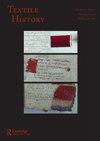Steven Toms, Financing Cotton: British Industrial Growth and Decline, 1780–2000
IF 0.1
2区 社会学
0 HUMANITIES, MULTIDISCIPLINARY
引用次数: 0
Abstract
practice, focusing upon Gaudiya Vaishnava imagery. For her, the visual stories of Krishna, the repetition of other motifs, and the rhythm of stitching combined to provide spiritual renewal and affirm her place in the spiritual world, apart from the earthly realm. While the case studies provide the specifics about kantha as the product of women’s voices otherwise silent in the written record, Ghosh throughout the volume pays attention to kantha not simply as a stable aesthetic work of art subject to formal analysis, as did Stella Kramrisch, but rather as a living entity that embodies intimacy across time and generations through realisation, use, maintenance and gifting. Attentive to the evidence of touch, smell, staining, fading and darning, Ghosh engages with kanthas as ‘textile transmissions’ (p. 64) that embody and shape a multi-generational investment. The physical evidence also evokes the many different functions these textiles provided, from warmth to an altar for puja. Finally, the care and attention to their cleaning, drying in the sun and storage in the off-season all speak to their enduring value. Ghosh’s fieldwork not only in Bengal but throughout different Bengali expatriate communities further underscores their continued value in linking generations across space. Although Ghosh’s volume is an important contribution to South Asian material culture, it should also be required reading for textile historians. It follows Linda Baumgarten’s lead in emphasising the importance of maintenance and refashioning, and quilting scholarship’s interest in textiles as important lenses into women’s worlds. Listening to the voices of the embroiderers as found in the physical evidence of kantha, Ghosh has written a powerful volume that documents the creation of memory through the making, use and care of a very specific textile.史蒂文·汤姆斯:《棉花融资:英国工业的增长与衰退,1780-2000》
练习,专注于高地亚毗湿奴形象。对她来说,克里希纳的视觉故事、其他主题的重复和缝合的节奏相结合,提供了精神上的更新,并肯定了她在精神世界中的地位,而不是世俗的境界。虽然案例研究提供了关于坎塔的细节,坎塔是女性声音的产物,否则在书面记录中是沉默的,但戈什在整本书中关注坎塔,并不仅仅是像斯特拉·克拉姆里希那样,将其视为一件经过形式分析的稳定美学艺术作品,而是一个通过实现、使用、,保养和礼品。Ghosh注意到触摸、气味、染色、褪色和织补的证据,将kanthas视为“纺织品传递器”(第64页),体现和塑造了多代人的投资。实物证据也唤起了这些纺织品所提供的许多不同功能,从温暖到puja祭坛。最后,对它们的清洁、在阳光下干燥和在淡季储存的关心和关注都说明了它们的持久价值。戈什不仅在孟加拉,而且在不同的孟加拉侨民社区进行的实地调查进一步强调了他们在跨越空间连接几代人方面的持续价值。尽管戈什的这本书是对南亚物质文化的重要贡献,但它也应该是纺织历史学家的必读书目。它遵循了Linda Baumgarten的领导,强调了维护和改造的重要性,以及绗缝奖学金对纺织品作为进入女性世界的重要镜头的兴趣。听着坎塔物证中刺绣师的声音,戈什写了一本强有力的书,记录了通过制作、使用和护理一种非常特殊的纺织品来创造记忆的过程。
本文章由计算机程序翻译,如有差异,请以英文原文为准。
求助全文
约1分钟内获得全文
求助全文
来源期刊

TEXTILE HISTORY
HUMANITIES, MULTIDISCIPLINARY-
CiteScore
1.00
自引率
0.00%
发文量
0
期刊介绍:
Textile History is an internationally recognised, peer reviewed journal and one of the leading publications in its field. It is viewed as an important outlet for current research. Published in the spring and autumn of each year, its remit has always been to facilitate the publication of high-quality research and discussion in all aspects of scholarship arising from the history of textiles and dress. Since its foundation the scope of the journal has been substantially expanded to include articles dealing with aspects of the cultural and social history of apparel and textiles, as well as issues arising from the exhibition, preservation and interpretation of historic textiles or clothing.
 求助内容:
求助内容: 应助结果提醒方式:
应助结果提醒方式:


